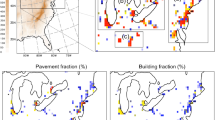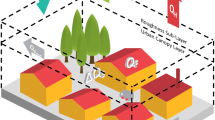Abstract
A direct comparison of urban and rural surface energy balances, as well as a variety of other variables including incoming shortwave/longwave radiation and aerosol optical depth, is conducted for the Beijing metropolitan area. The results indicate that, overall, the urban area receives a smaller amount of incoming shortwave radiation but a larger amount of incoming longwave radiation. However, comparisons in the aerosol optical depth and cloud fraction at the two locations suggest that neither aerosol optical depth nor cloud fraction alone can explain the difference in the incoming shortwave radiation. The urban-rural differences in the incoming longwave radiation are unlikely to be caused by the presence of more abundant greenhouse gases over the urban area, as suggested by some previous studies, given that water vapor is the most dominant greenhouse gas and precipitable water is found to be less in urban areas. The higher incoming longwave radiation observed over the urban area is mostly likely due to the higher temperatures of the ambient air. The urban area is also found to always produce higher sensible heat fluxes and lower latent heat fluxes in the growing season. Furthermore, the urban area is associated with a larger amount of available energy (the sum of sensible and latent heat fluxes) than the rural area, except in May and October when evapotranspiration in the rural area significantly exceeds that in the urban area. This study provides observational evidence of urban-rural contrasts in relevant energy-balance components that plausibly arise from urban-rural differences in atmospheric and land-surface conditions.
Similar content being viewed by others
References
Arnfield, A. J., 2003: Two decades of urban climate research: A review of turbulence, exchanges of energy and water, and the urban heat island. Int. J. Climatol., 23(1), 1–26.
Bornstein, R., and Q. L. Lin, 2000: Urban heat islands and summertime convective thunderstorms in Atlanta: Three case studies. Atmos. Environ., 34(3), 507–516.
Britter, R. E., and S. R. Hanna, 2003: Flow and dispersion in urban areas. Annu. Rev. Fluid. Mech., 35, 469–496.
Brutsaert, W., 1982: Evaporation into the Atmosphere: Theory, History, and Applications. Springer, Netherlands, 299 pp.
Che, H. Z., and Coauthors, 2009: Instrument calibration and aerosol optical depth validation of the China Aerosol Remote Sensing Network. J. Geophys. Res., 114, D03206, doi: 10.1029/2008JD011030.
Chen, F., and Coauthors, 2011: The integrated WRF/urban modelling system: Development, evaluation, and applications to urban environmental problems. Int. J. Climatol., 31(2), 273–288.
Cleugh, H. A., and T. R. Oke, 1986: Suburban-rural energybalance comparisons in summer for Vancouver, B. C. Bound.-Layer Meteor., 36(4), 351–369.
Eck, T. F., B. N. Holben, J. S. Reid, O. Dubovik, A. Smirnov, N. T. O’Neill, I. Slutsker, and S. Kinne, 1999: Wavelength dependence of the optical depth of biomass burning, urban, and desert dust aerosols. J. Geophys. Res., 104(D24), 31 333–31 349.
Gong, P., and Coauthors, 2012: Finer resolution observation and monitoring of global land cover: First mapping results with Landsat TM and ETM+ data. Int. J. Remote Sens., 34(7), 2607–2654.
Grimm, N. B., S. H. Faeth, N. E. Golubiewski, C. L. Redman, J. G. Wu, X.M. Bai, and J. M. Briggs, 2008: Global change and the ecology of cities. Science, 319(5864), 756–760.
Grimmond, C. S. B., and T. R. Oke, 1995: Comparison of heat fluxes from summertime observations in the suburbs of 4 North-American cities. J. Appl. Meteor., 34(4), 873–889.
Grimmond, C. S. B., and T. R. Oke, 1999: Heat storage in urban areas: Local-scale observations and evaluation of a simple model. J. Appl. Meteor., 38(7), 922–940.
Grimmond, C. S. B., T. R. Oke, and H. A. Cleugh, 1993: The role of “rural” in comparisons of observed suburban-rural flux differences. Exchange processes at the land surface for a range of space and time scales, International Association of Hydrological Sciences Publication, 212, 165–174.
Grimmond, C. S. B., and Coauthors, 2010: The international urban energy balance models comparison project: First results from phase 1. J. Appl. Meteor. Climol., 49(6), 1268–1292.
Grimmond, C. S. B., and Coauthors, 2011: Initial results from Phase 2 of the international urban energy balance model comparison. Int. J. Climatol., 31(2), 244–272.
Grimmond, S., 2007: Urbanization and global environmental change: Local effects of urban warming. Geophys. J., 173, 83–88.
Hu, X. M., P. M. Klein, M. Xue, J. K. Lundquist, F. Zhang, and Y. Qi, 2013: Impact of low-level jets on the nocturnal urban heat island intensity in Oklahoma City. J. Appl. Meteor. Climatol., 52(8), 1779–1802.
Holben, B. N., and Coauthors, 1998: AERONET-A federated instrument network and data archive for aerosol characterization. Remote. Sens. Environ., 66(1), 1–16.
Jin, M. L., and J. M. Shepherd, 2008: Aerosol relationships to warm season clouds and rainfall at monthly scales over east China: Urban land versus ocean. J. Geophys. Res., 113, doi:10.1029/2008JD010276.
Jin, M. L., J. M. Shepherd, and W. Z. Zheng, 2010: Urban surface temperature reduction via the urban aerosol direct effect: A remote sensing and WRF model sensitivity study. Adv. Meteor., Article ID 681587, doi:10.1155/2010/681587.
Kanda, M., 2007: Progress in urban meteorology: A review. J. Meteor. Soc. Japan, 85B, 363–383.
Kanda, M., R. Moriwak, M. Roth, and T. Oke, 2002: Areaaveraged sensible heat flux and a new method to determine zero-plane displacement length over an urban surface using scintillometry. Bound.-Layer Meteor., 105(1), 177–193.
Li, D., and E. Bou-Zeid, 2011: Coherent structures and the dissimilarity of turbulent transport of momentum and scalars in the unstable atmospheric surface layer. Bound.-Layer Meteor., 140(2), 243–262.
Li, D., and E. Bou-Zeid, 2013: Synergistic interactions between urban heat islands and heat waves: The impact in cities is larger than the sum of its parts. J. Appl. Meteor. Climtol., 52, 2051–2064.
Li, D., E. Bou-Zeid, M. L. Baeck, S. Jessup, and J. A. Smith, 2013: Modeling land surface processes and heavy rainfall in urban environments: Sensitivity to urban surface representations. J. Hydrometeor., 14, 1098–1118.
Li, Q. S., L. H. Zhi, and F. Hu, 2010: Boundary layer wind structure from observations on a 325 m tower. J. Wind Eng. Ind. Aerodyn., 98(12), 818–832.
Lin, C. Y., W. C. Chen, P. L. Chang, and Y. F. Sheng, 2011: Impact of the urban heat island effect on precipitation over a complex geographic environment in Northern Taiwan. J. Appl. Meteor. Climtol., 50(2), 339–353.
Loose, T., and R. D. Bornstein, 1977: Observations of mesoscale effects on frontal movement through an urban area. Mon. Wea. Rev., 105(5), 563–571.
Loridan, T., and C. S. B. Grimmond, 2012: Characterization of energy flux partitioning in urban environments: Links with surface seasonal properties. J. Appl. Meteor. Climatol., 51(2), 219–241.
Miao, S. G., P. Y. Li., and X. Y. Wang, 2009: Building morphological characteristics and their effect on the wind in Beijing. Adv. Atmos. Sci., 26(6), 1115–1124, doi: 10.1007/s00376-009-7223-7.
Miao, S. G., F. Chen, Q. C. Li, and S. Y. Fan, 2011: Impacts of urban processes and urbanization on summer precipitation: A case study of heavy rainfall in Beijing on 1 August 2006. J. Appl. Meteor. Climatol., 50(4), 806–825.
Miao, S. G., J. X. Dou, F. Chen, J. Li, and A. G. Li, 2012: Analysis of observations on the urban surface energy balance in Beijing. Sci. China Earth Sci., 55(11), 1881–1890.
Nordbo, A., L. Järvi, S. Haapanala, J. Moilanen, and T. Vesala, 2013: Intra-city variation in urban morphology and turbulence structure in Helsinki, Finland. Bound.-Layer Meteor., 146(3), 469–496.
Ntelekos, A. A., J. A. Smith, L. Donner, J. D. Fast, W. I. Gustafson, E. G. Chapman, and W. F. Krajewski, 2009: The effects of aerosols on intense convective precipitation in the northeastern United States. Quart. J. Roy. Meteor. Soc., 135(643), 1367–1391.
O’Neill, N. T., T. F. Eck, A. Smirnov, B. N. Holben, and S. Thulasiraman, 2003: Spectral discrimination of coarse and fine mode optical depth. J. Geophys. Res., 108, 4559, doi:10.1029/2002JD002975.
Oke, T. R., 1982: The energetic basis of the urban heat island. Quart. J. Roy. Meteor. Soc., 108(455), 1–24.
Peterson, J. T., and T. L. Stoffel, 1980: Analysis of urban-rural solar-radiation data from St-Louis, Missouri. J. Appl. Meteor., 19(3), 275–283.
Piringer, M., and Coauthors, 2002: Investigating the surface energy balance in urban areas-recent advances and future needs. Water, Air, and Soil Pollution: Focus, 2(5–6), 1–16.
Rosenfeld, D., U. Lohmann, G. B. Raga, C. D. O’Dowd, M. Kulmala, S. Fuzzi, A. Reissell, and M. O. Andreae, 2008: Flood or drought: How do aerosols affect precipitation?. Science, 321(5894), 1309–1313.
Shephard, J.M., 2005: A review of current investigations of urbaninduced rainfall and recommmendations for the future. Earth Interact, 9, 1–27.
Tan, M. H., and X. B. Li, 2013: Integrated assessment of the cool island intensity of green spaces in the mega city of Beijing. Int. J. Remote Sens., 34(8), 3028–3043.
The Office of the Sixth National Census Beijing (OSCB), 2011: The characteristics of Beijing’s population distribution. [Available online at http://www.bjstats.gov.cn/rkpc6/pcsj/ (Accessed Mar 19, 2013).]
Wang, L. L., D. Li, Z. Q. Gao, T. Sun, X. F. Guo, and E. Bou-Zeid, 2014: Turbulent transport of momentum and scalars above an urban canopy. Bound.-Layer Meteor., 150, 485–511.
Wood, C. R., and Coauthors, 2010: Turbulent flow at 190 m height above London during 2006–2008: A climatology and the applicability of similarity theory. Bound.-Layer Meteor., 137(1), 77–96.
Xia, X. A., H. B. Chen, P. C. Wang, W. X. Zhang, P. Goloub, B. Chatenet, T. F. Eck, and B. N. Holben, 2006: Variation of column-integrated aerosol properties in a Chinese urban region. J. Geophys. Res., 111(D5), doi: 10.1029/2005JD 006203.
Xia, X. A., Z. Li, P. Wang, H. Chen, and M. Cribb, 2007: Estimation of aerosol effects on surface irradiance based on measurements and radiative transfer model simulations in northern China. J. Geophys. Res., 112(D22), doi: 10.1029/2006JD 008337.
Yuan, T., L. A. Remer, and H. Yu, 2011: Macrophysical, microphysical and radiative signatures of volcanic aerosols in trade wind cumulus observed by the A-Train. Atmos. Chem. Phys., 11, 7119–7132, doi:10.5194/acp-11-6415-2011.
Zhang, C. L., F. Chen, S. G. Miao, Q. C. Li, X. A. Xia, and C. Y. Xuan, 2009: Impacts of urban expansion and future green planting on summer precipitation in the Beijing metropolitan area. J. Geophys. Res., 114, D02116, doi: 10.1029/2008JD010328.
Zhang, N., L. Zhu, and Y. Zhu, 2011: Urban heat island and boundary layer structures under hot weather synoptic conditions: A case study of Suzhou City, China. Adv. Atmos. Sci., 28(4), 855–865, doi: 10.1007/s00376-010-0040-1.
Author information
Authors and Affiliations
Corresponding author
Rights and permissions
About this article
Cite this article
Wang, L., Gao, Z., Miao, S. et al. Contrasting characteristics of the surface energy balance between the urban and rural areas of Beijing. Adv. Atmos. Sci. 32, 505–514 (2015). https://doi.org/10.1007/s00376-014-3222-4
Received:
Revised:
Accepted:
Published:
Issue Date:
DOI: https://doi.org/10.1007/s00376-014-3222-4




